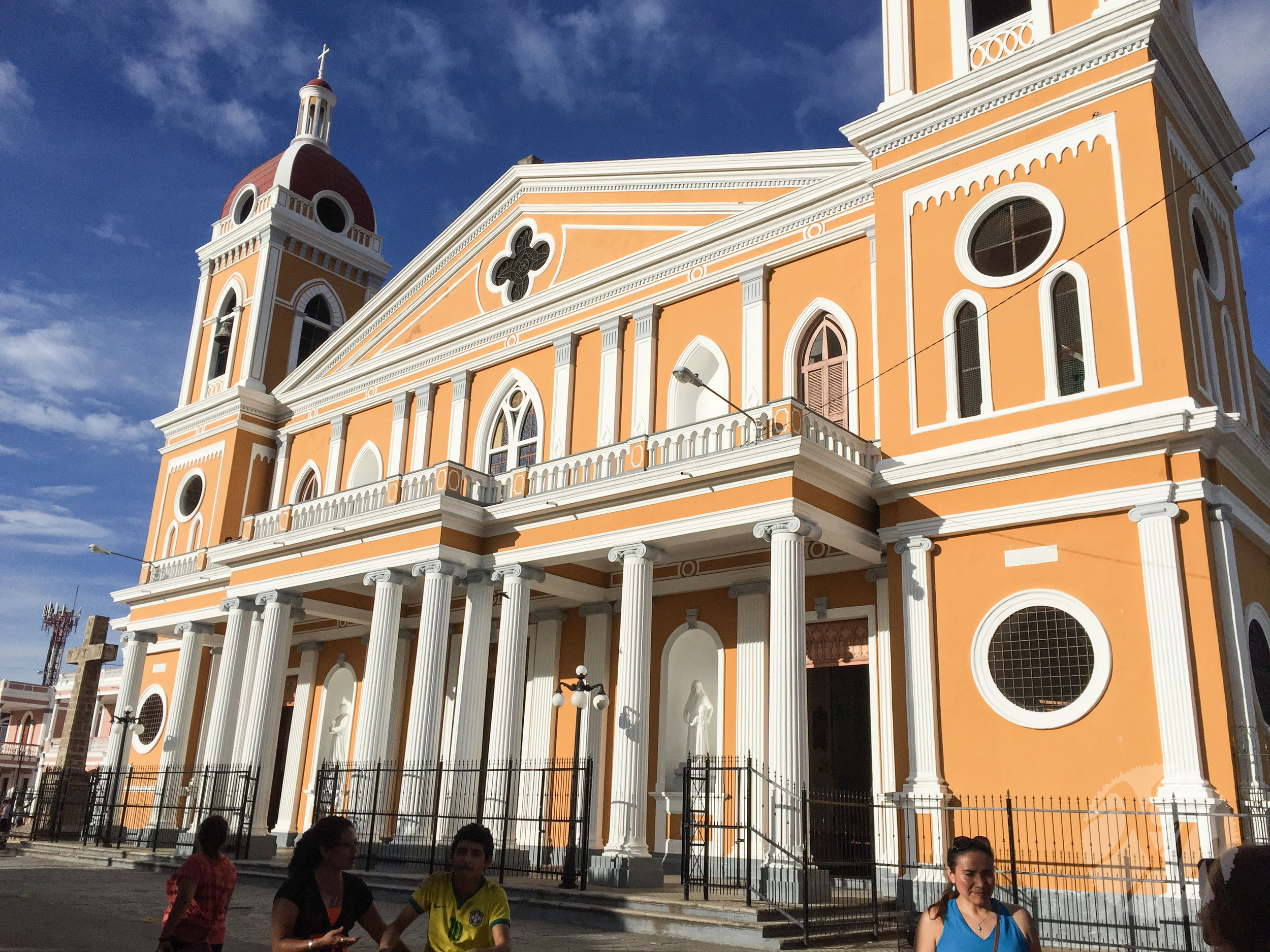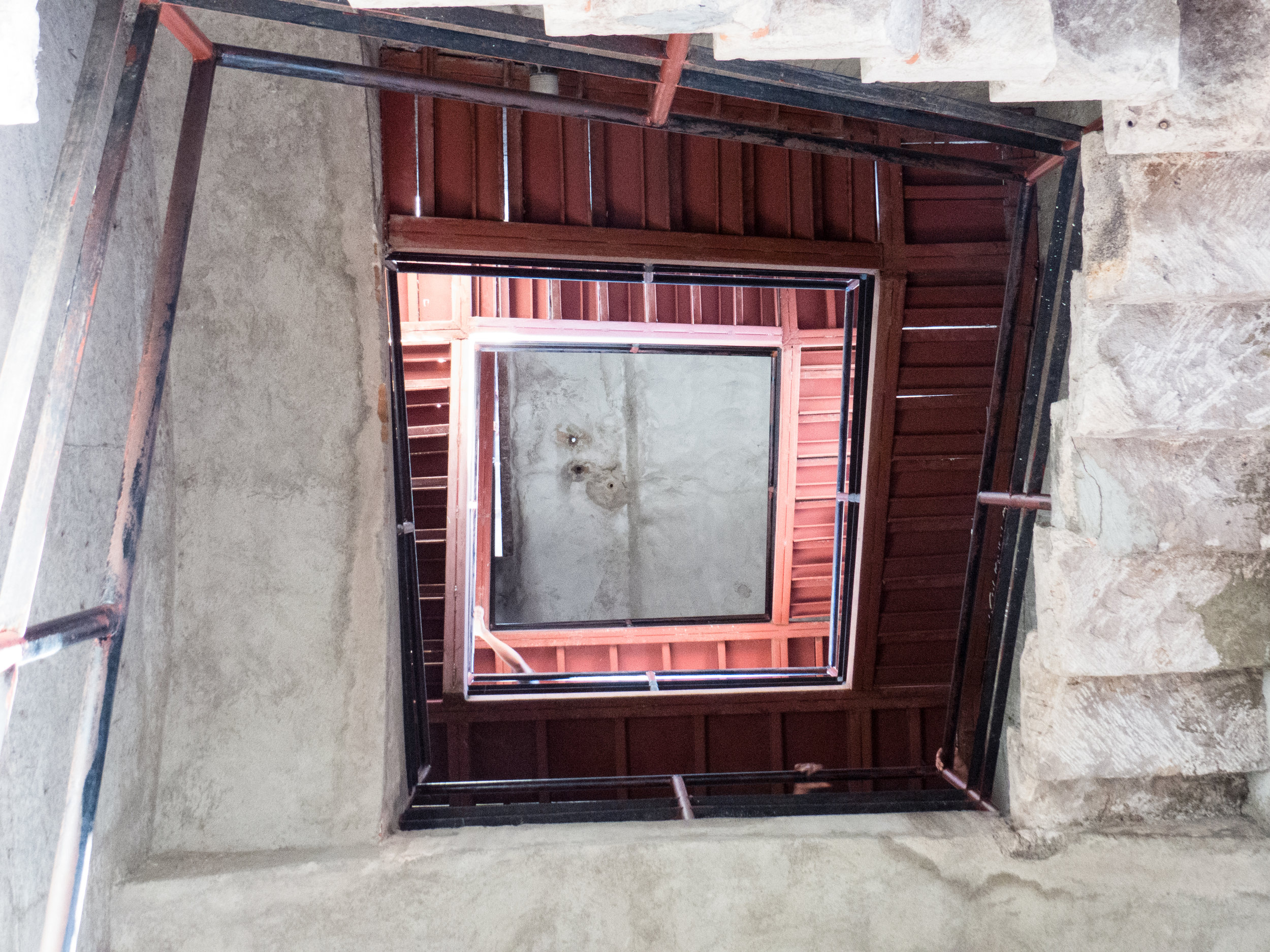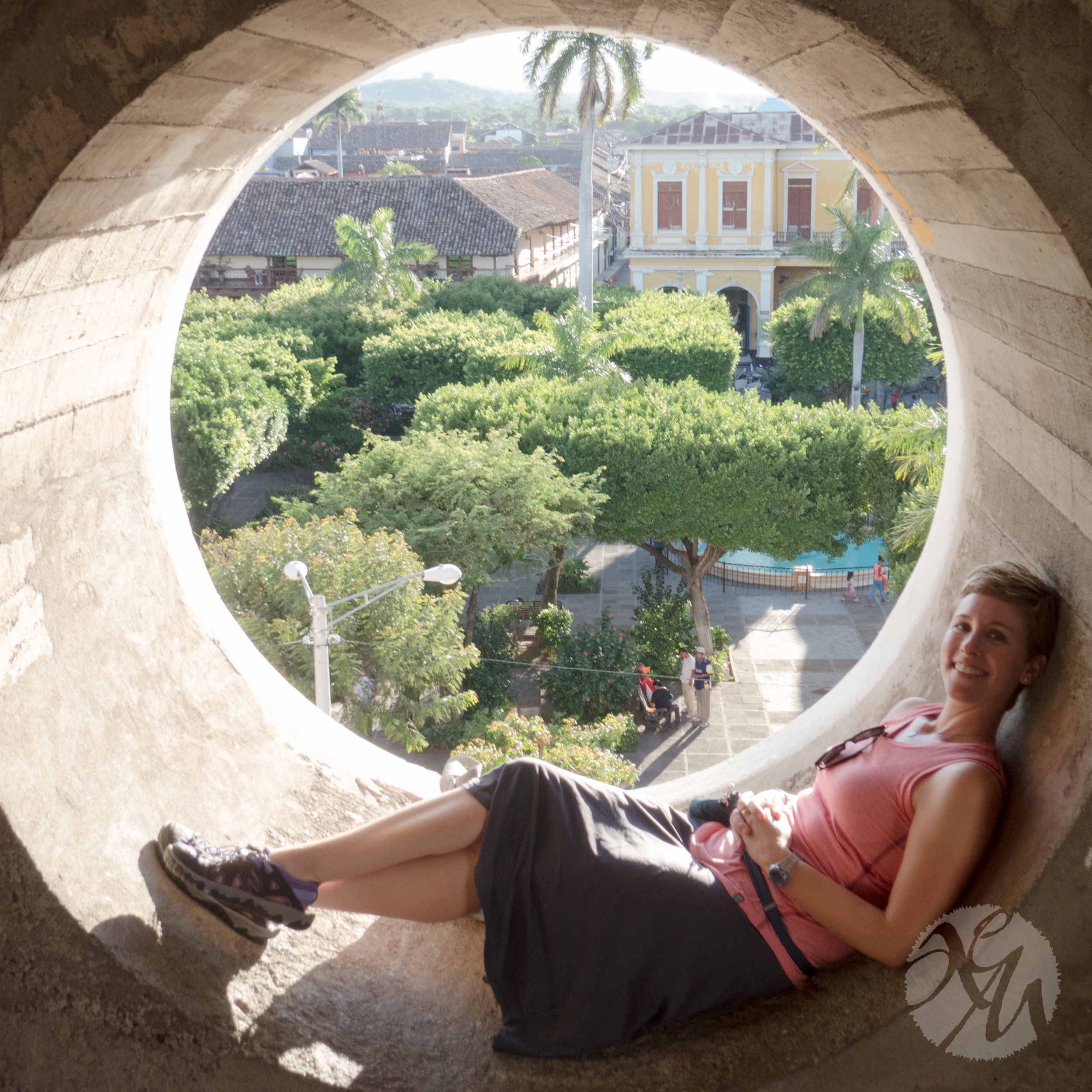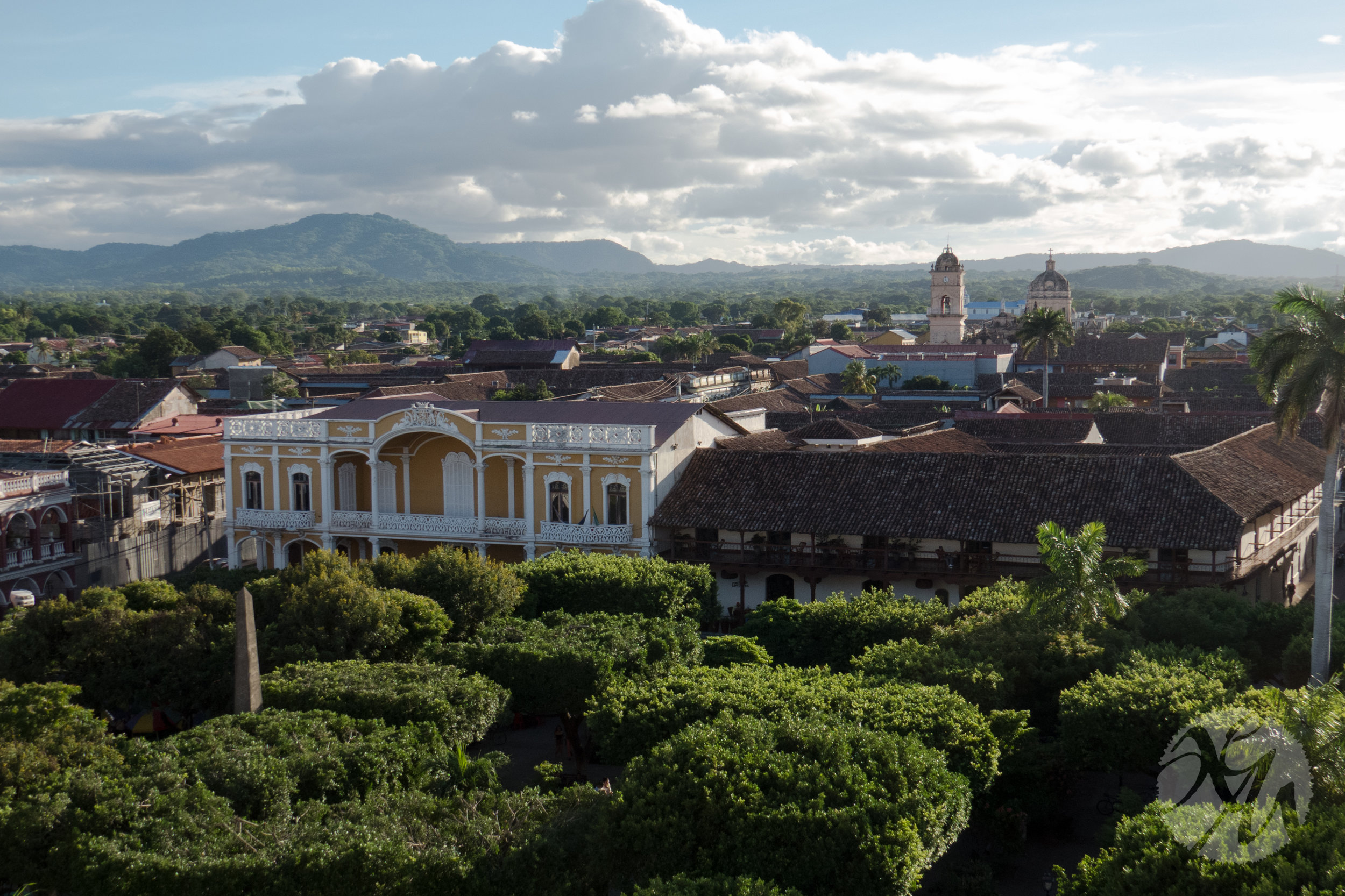Week 19: Nicaraguan Vacation
[Need to catch up on my previous stories from Nicaragua? Start with this short primer on the country, then read about my intrepid decision to visit. Jump from there to learn about the three life perspectives I gained during my week in the country, and then I suggest reading about school life in the rural campo. Finally, I shared the story of my most uncomfortable moments of the trip while we were staying in Matagalpa. After that, you’re caught up!]
I was not sorry to say goodbye to Matagalpa early on Sunday morning.
Our departure from that city in the mountains closed the book on the purposeful, volunteering part of our group’s adventures. After that? We were all ready for some vacation!
Colorful Granada
Descending from the cool mountain region toward sea-level Granada, the landscape and climate alike transitioned. Heat and humidity reminded us that we really were just 12° north of the equator. We may have driven out of the mountains and onto the flatter sea-level landscape, but we started seeing some of Nicaragua’s chain of 19 volcanoes that mostly line up along the Pacific coastal region.
What first struck me about Granada was its vibrant color as we drove into the city; every building was a different shade of tropical. Founded in 1524, many argue that it was the first European city in mainland America, and it feels like it: multiple cathedrals, open-air markets, cafés spilling onto the sidewalks, and plenty of leisure activities designed for tourists.
Heaven, in the form of a hotel with air-conditioned rooms, hot water, and a quiet courtyard.
Each of us got very excited about our hotel as we unloaded the van and peered inside. Like many hotels and restaurants in both Granada and León, the Hotel Patio del Malinche rooms had open-air entry that faced a landscaped interior courtyard. Our rooms were air-conditioned (luxury!), the showers had hot water from the tap (heaven!), and in the center of the courtyard was a serene pool surrounded by palm trees, lounge chairs, and hammocks (can I just hang out there the rest of the day?).
Cabins and hostels and homes protected by razor wire no more! I was ready to go to bed and sleep, sleep, sleep in that beautiful bed, and we hadn’t even truly seen the city.
A top tourist activity when in Granada: a boat tour of Las Isletas.
After a leisurely lunch that included tropical smoothies for appetizers and a table next to another landscaped courtyard lined with hammocks (so many hammocks!), we took a guidebook-approved boat tour of Las Isletas, a collection of more than 300 tiny islands on Lago Cocibolca (a.k.a. Lake Nicaragua). Some of the little islands were big enough to host a small hotel or large home, while others were barely large enough for a person to stand on. Supposedly, this archipelago was formed by a volcanic eruption centuries ago.
My favorite view from the boat tour was of Mombacho, a quiet volcano that last erupted in the 1500s.
Mombacho, a quiet volcano near Granada.
Post-boat tour (enjoyed while sipping some fruity drinks made with the local rum), our group split in two: some stayed at the hotel to enjoy the pool, while the rest of us went to Granada’s most recognizable cathedral, the Cathedral of Granada. It’s a striking yellow-and-white cathedral originally built in 1583 as a parochial church but essentially finished in 1915.
Visitors can pay $1.00 to climb to the bell tower, an experience that again reminded me that we weren’t in the States anymore. As we climbed to the top, the stairs became more and more narrow—to a final width of about 10 inches as we crouched under the concrete ceiling over the last flight. On the way up, we passed a large, circular, unbarred window that offered a unique seat and view overlooking the city.
That evening in Granada was when I felt the most at ease and relaxed on the whole trip: a day of sightseeing (during which I felt comfortable and safe), an hour in the pool, a good shower, and a nice dinner at which I laughed at levels I rarely reach. You know, the ugly, crying laughing where you can’t hardly see and definitely can’t speak normally. I was sorry to be saying goodbye to my new friends, but it was a lovely way to leave on a high note.
Laguna de Apoyo and the Road to León
Most of our group departed for home that Monday, but Stefani had made the choice to stay an extra day to save $700 on airfare back to San Francisco. Kristin and I invited her to spend the day with us, and we left Granada behind to spend the afternoon at Laguna de Apoyo.
Pristine and serene Laguna de Apoyo.
Laguna de Apoyo is a volcanic crater lake formed approximately 23,000 years ago. For $6.00 each, we spent the afternoon using the amenities of a lakeside hotel and day-cation place called the Monkey Hut, which included use of their kayaks and life jackets, inner tubes, beach, hammocks and lounge chairs, and free coffee at the bar. The three of us made a beeline for the kayaks first.
While floating in the middle of the lake, the color of the water struck me: it was black, a very different color than I’m used to seeing. But most surprisingly, when I stuck my paddle or foot into the water a few inches, I could see that the water was actually quite clear. The color is caused by the black volcanic sand that lines the lake, and the surrounding lands are relatively undeveloped and thus haven’t polluted it.
For the whole afternoon, we saw perhaps 20 other people on the entire lake (more than 5,000 acres of surface area in a nearly perfect circle) and just one motored boat. I’m accustomed to seeing even small lakes in the U.S. filled to the brim with boats and floaters, so the serenity of this place was unusual in a very good way. The quiet was only disturbed by the calls of birds and vocal howler monkeys.
Non-Creepy Cab Drivers and a Reminder of Reality
Kristin, my extroverted, intrepid friend, in her years in Nicaragua, has made friends with a local cab driver, Nikita, who she calls for transportation all across the region. Nikita is a former child soldier who was selling small trinkets and wares on the streets when he was picked up by a nonprofit organization and taught to be a mechanic. Decades later, now a grandfather, he earns his living doing both mechanic work and driving a cab. Kristin affectionately says he’s the most non-creepy Nicaraguan man she’s met, and she knows him well enough to have dinner with his family when she’s in town.
Cab drivers in Nicaragua drive well beyond the boundaries of their base cities. On this day, Nikita drove an hour or more from his home in Managua to pick us up in Granada, took us to Laguna de Apoyo and waited all day while we kayaked and swam, drove us to Managua to drop Stefani at her hotel near the airport, waited while we ate dinner with her, drove Kristin and me the two hours on to León, then finally went back home to Managua himself.
I personally felt awkward and uncomfortably self-important by monopolizing his whole day. But Kristin taught me about the reality of the situation in this country: her regular employment of him, paying him for a full day of work on a regular basis, has enabled him to provide extra, beyond-basics support for his family. Kristin has an agreement with him that she will call him first when she’s in the country and needs transportation, and he appreciates that income security.
That night, on the dark road from Managua to León, after an idyllic couple of days in Granada and the pristine Laguna de Apoyo, we came upon a scene that brought reality screaming back.
Driving along roads throughout the country, we frequently saw pedestrians, day or night, busy highway or quiet rural trail. It was no different this night, after dark, on a busy two-lane highway between two major cities. With no intersection in sight, we saw brake lights ahead, and traffic slowed to a crawl. Emergency lights were flashing in response to an accident on the road. It wasn’t until we were passing the scene ourselves that I saw what had happened: a man walking along the road had been struck and killed.
While the hypothetical idea of this is not surprising—walking on the shoulder of a busy road after dark is inherently dangerous—seeing the man lying face down, recently killed, exposed, on the road just a few feet away made my stomach lurch. A group of people, police and I assume those involved in the accident, were standing about 10 feet away, while lights from the vehicles shone on the man lying ignored and abandoned on the ground.
I’ve watched my share of crime dramas, violent movies, and the like, but even in most of those fictional stories, you’ll see the victims fall, then the camera turns away, and you next see them covered, shielded from prying eyes. Not in Nicaragua.
Kristin told me it’s scenes like this that led she and a friend to describe life in Nicaragua with one word: raw. You see everything.
That disturbing sight sat in my stomach for hours afterward. Even after getting to León, settling in, and tucking myself safely into another nice bed in an air-conditioned hotel room, I had to read a book for a while to clear my head and be able to fall asleep.
It’s not a scene I’ll ever forget.
Liberal León
By 10:00 a.m. the next morning, temperatures in León had already passed 80°F, and the air was thick with humidity. After a leisurely breakfast, Kristin and I walked to the Cathedral of León, a white-concrete structure with unique dome architecture on the roof.
While Nicaragua has a long and storied history as one of the earliest Spanish colonies in the New World, numerous conflicts over the centuries and the current state of poverty have together resulted in historic buildings standing in disrepair. Cathedrals, which I’m used to seeing maintained in pristine condition, look battered. This cathedral, though, was undergoing a facelift, with one side mostly done and the front side untouched; it appeared to be a before-and-after pair of photographs in one real-life moment.
Pay $3.00 and you can climb to the bell tower and walk around on the roof after you take your shoes off. This otherworldly landscape was unlike any other cathedral I’ve seen or visited in my life, and on a hot, sunny day in the tropics, that white, concrete surface toasted the bottoms of our feet. We scurried from one tiny patch of shade to another to give our feet a moment of relief.
The view, though, was stunning enough that I was able to periodically forget about my frying feet. Not only does the roof of this cathedral afford you a view over the city in all directions, but you can see the string of volcanoes (about six of them, three of which are currently active) that border the city from northwest to southeast.
I desperately needed a cold bottle of water after our time on the roof, so we grabbed one and walked a few blocks to the Museo de Arte Fundación Ortiz-Gurdián, a privately owned contemporary art museum with a truly impressive collection. Because it’s privately owned, the facility was well funded and maintained, though I was saddened to find that this building, like most others in the country, was not climate-controlled. All the heat and humidity of the day flowed freely through the open-air museum and touched each piece of artwork.
By this point, both Kristin and I were low on energy and motivation from the heat, so we found a lovely French bakery-cafe, had freshly pressed and mixed juices, and went back to the hotel for a couple hours’ siesta.
An Atmosphere of Progress
León, over the years, was favored by the liberal parties in each of the various conflicts and revolutions, and it served as Nicaragua’s capital city off and on (it flipped between it and Granada) before the middle-ground Managua was settled in truce. León hosts about nine universities today, by my count, and I could tell: the local population was noticeably school-aged and youthful compared to many other places I visited.
Kristin and I got an early dinner at an outdoor restaurant on the plaza in front of the Cathedral—perfect for people-watching—and as we were sitting there, a man who’d been sitting at the table next to us working on his laptop approached our table. He addressed Kristin in Spanish and said that he was taking English classes. For his homework, he was instructed to conduct a short interview in English and record it on video, so he asked if he could interview us. We agreed, and he proceeded to ask us polite questions about where we were from, what we did for a living, and what we liked about Nicaragua. He graciously thanked us when he was done and went back to his table.
About thirty minutes later, the same man came back to our table, this time accompanied by a teenage girl wearing a school uniform. He introduced her as his daughter, Jasmine, and said that she’s taking the same English class and had the same homework, so could she interview us, too? We agreed, of course, and she nervously asked us the same questions while we did our best to speak slowly and clearly and be as unintimidating as possible while her father sat next to her. After they returned to his table, she pressed her hands to her chest in relief as her nerves began to calm. I can empathize with how much courage that took to approach us!
The Trip Comes to an End
Our vacation drew to a close as Nikita again collected us after dinner and drove us the two (uneventful) hours back to the Best Western across the street from the airport in Managua.
What a difference that second stay was. On my first night in the country, in that same hotel, I’d begun my personal pep talks as I prepared to stay in hotels and cabins that were more primitive than I was used to. But on this, my last night, the air-conditioned room, full-sized bathroom with running hot water, and crisp white sheets were a comfort.
I focused less on the differences and more on the amenities that I’d come to newly appreciate. I fell asleep just moments after my head hit the pillow, ready to drag myself out of bed at 4:30 the next morning to embark on my trip home.






![Week 22: Summer Concerts and Social Intrepidity [Score +22]](https://images.squarespace-cdn.com/content/v1/58b4c7cc20099e8b54a9ad11/1502065505230-62Y2P41LX5DOPRBJT4AV/EagleCrConcert-aem-1.jpg)
![Week 21: An Afternoon at a Museum [Score +2]](https://images.squarespace-cdn.com/content/v1/58b4c7cc20099e8b54a9ad11/1500942956825-EGO2NYO2NK724KJYOL3E/Eiteljorg-100-aem.jpg)


